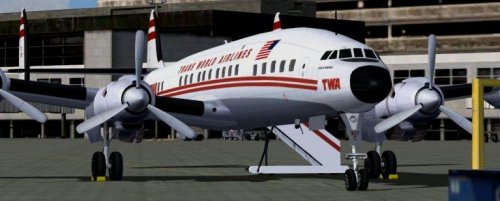

In 1955, Pan American had ordered the Douglas DC-7C Seven Seas, with the ability to fly the Atlantic non-stop in almost any weather. To counter this threat, TWA asked Lockheed to develop a new version of the Constellation with increased range and capacity. Lockheed initially returned with a design that included turboprop engines and a lengthened wing. TWA wanted the fuselage extended as well, but Lockheed refused, since the extra cost was not justified by the limited sales potential (considering the impending introduction of long-range jets). This was designated the L1449, and was ordered by TWA. Later, Lockheed learned that the planned turbprops would need heavy containment structures in the nacelles which would make the plane totally impractical, and thus proposed instead a version with more powerful R3350's instead. Many TWA officials felt this plane would not be sufficiently superior to the DC-7C to justify it's purchase (talks with Douglas about purchasing DC-7C's were also ongoing during this period, and Douglas had actually set aside some production slots for TWA early in its development). However, by that time the DC-7C production slots had been already given to another airline, and Howard Hughes (then in control of TWA) insisted that Lockheed produce the modified plane, now designated the L-1649A Starliner.
The plane that resulted was the last major piston-engined airliner designed and built for the US and international market before the wave of jets arrived. The Starliner had the greatest range of any piston airliner, over 7,000 miles. However, it was slightly slower than the DC-7C, which was a great dissapointment to TWA. In fact. like the DC-7C, the Starliner proved to be less economical to operate than the earlier Connies such as the 749 and 1049G, and had relatively short lives with TWA. Perhaps because of these marginal economics and the planes late arrival (TWA put the 1649A into service in June, 1957, less than a year and a half before the first jets arrived), the only other purchasers were Air France and Lufthansa, airlines with large Constellation fleets. TWA ended up with 29, while Air France had 10 and Lufthansa had 4. Only Air France used the Starliner name; they were Jetstreams to TWA and Super Stars to Lufthansa. Another airline to order the L-1649A, LAI of Italy, then merged with Alitalia (which had ordered DC-7C's), and LAI's 4 were added to TWA's original order of 25. Varig (Brazil) also ordered 2 L-1649A's, but changed the order to L-1049G's for standardization. A US Navy AEW version was designed, but military budget restraints forced its cancellation.
Due the the almost immediate arrival of the jets, Starliners had quite short lives in their intended service. TWA and others converted most of them to freighters, or sold them to other airlines. Alaska used two for MATS flights in the 60's, and a few other airlines used them for charter work. They generally did not have long lives but there are 4 still in existence, 3 with Lufthansa (1 flyable) and one at the South Africa Airways Museum.
Add the CalClassic Notepads to the panel.
 FS2004 TWA Lockheed L-1649A
Starliner. Manfred Jahn has created this most wonderful plane, now
in Version 4 with the help of Volker Bohme, Luis Pallas, Bill Tyne and Stefan
Werner. Clicking on the image will download v4.0, that includes a Lufthansa
livery. Add the
TWA textures from the v2.2 package. TWA used them in premier long-distance
runs until the jets arrived, including San Francisco/Los Angeles-London "over
the pole" service. After the jets, most were converted to freighters and
flew international cargo services. They were known as the "Queen of the
Skies", and passengers loved them for their luxury, comfort, and quiet. Thanks
so much! Last updated on 12/23/12. FSX
Supercharger fix. Last updated on 4/28/11.
FS2004 TWA Lockheed L-1649A
Starliner. Manfred Jahn has created this most wonderful plane, now
in Version 4 with the help of Volker Bohme, Luis Pallas, Bill Tyne and Stefan
Werner. Clicking on the image will download v4.0, that includes a Lufthansa
livery. Add the
TWA textures from the v2.2 package. TWA used them in premier long-distance
runs until the jets arrived, including San Francisco/Los Angeles-London "over
the pole" service. After the jets, most were converted to freighters and
flew international cargo services. They were known as the "Queen of the
Skies", and passengers loved them for their luxury, comfort, and quiet. Thanks
so much! Last updated on 12/23/12. FSX
Supercharger fix. Last updated on 4/28/11.
FSX/P3D MDL Files. I have converted the MDL files to FSX native format, for use with FSX and P3D. Last updated on 11/4/20.